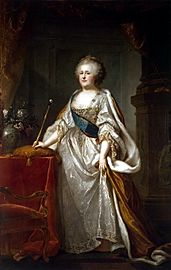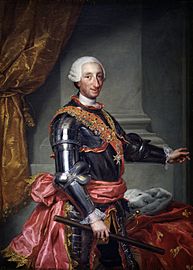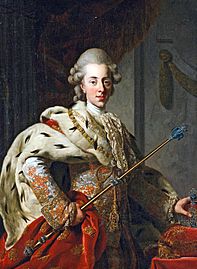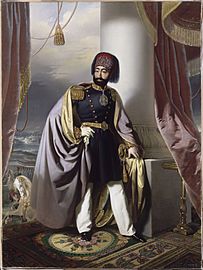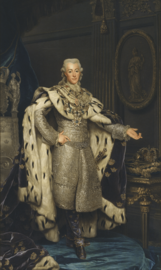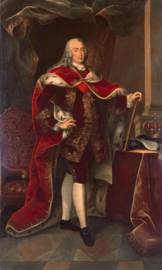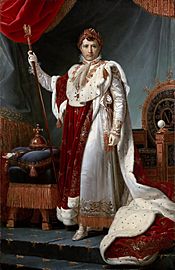Enlightened absolutism facts for kids
Enlightened absolutism (also called enlightened despotism) was a way of ruling in Europe during the 1700s and early 1800s. It involved kings and queens who had total power, but they were also influenced by new ideas from the the Enlightenment. These rulers believed they should use their power to make their people's lives better.
An enlightened ruler was not chosen by the people. They were like a dictator, but they claimed to rule for the good of everyone. They often believed they were meant to rule. Some of these rulers even helped end serfdom (a system where peasants were tied to the land). For example, Emperor Joseph II of the Holy Roman Empire ruled with the idea: "Everything for the people, nothing by the people." This meant he wanted to do good things for his people, but they had no say in how he ruled.
Contents
How Enlightened Absolutism Started
The idea of enlightened absolutism became popular during the Enlightenment. This was a time when thinkers focused on reason, science, and human rights. One famous ruler, Frederick the Great, who was king of Prussia from 1740 to 1786, wrote an essay defending this way of governing.
Frederick was a big fan of French ideas. When the French philosopher Voltaire had problems in France, Frederick invited him to live at his palace. Voltaire believed that a wise king was the best way for society to improve. Frederick himself said his main job was "to fight against ignorance and prejudice." He wanted to "enlighten minds, improve morals, and make people as happy as possible."
Enlightened rulers believed their power came from a social contract. This was an idea that people gave power to the ruler to govern them, instead of power coming from God (which was called divine right). These monarchs tried to make their rule stronger by improving their subjects' lives. However, because the monarch took all the responsibility, people didn't get to take part in political decisions.
Historians still discuss how much these rulers truly embraced the Enlightenment. Some rulers, like Frederick the Great, studied Enlightenment ideas in their private lives. But they sometimes found it hard to make big changes in how their countries were run. Other leaders, like the Marquis of Pombal in Portugal, used Enlightenment ideas. They used them to make reforms, but also to gain more power and stop people who disagreed with them.
Enlightened Rulers in Different Countries
Governments reacted differently to the Age of Enlightenment. Some powerful rulers, known as "enlightened despots," welcomed Enlightenment thinkers. They even asked them to help create new laws and programs to make their countries stronger. In France, however, the government was against these new ideas. The British government mostly ignored the Enlightenment leaders.
Prussia: Frederick the Great
Frederick the Great ruled Prussia from 1740 to 1786. He loved French ideas and even made fun of German culture. He invited the famous French writer Voltaire to live with him. Frederick believed his job was to fight ignorance and make his people happy. He wrote an essay supporting this type of government.
Russia: Catherine the Great
Empress Catherine II of Russia supported the Russian Enlightenment. She used many ideas from Enlightenment thinkers, especially Montesquieu, in her plan to change Russian law. However, inviting the French philosopher Denis Diderot to her court didn't work out well.
Spain: Charles III
Charles III of Spain was King of Spain from 1759 to 1788. He tried to improve his empire by making many changes. He weakened the power of the Church, supported science and universities, and made trade easier. He also tried to modernize agriculture and avoid wars. But his efforts to centralize power made local nobles angry. Because of this, Spain went back to its old ways after he died.
Austria: Joseph II
Emperor Joseph II ruled Austria from 1780 to 1790. He was very eager to make reforms. He announced so many changes that people didn't support them. This led to revolts, and his rule became very chaotic.
Portugal and Denmark
In some countries, the reforms came from important officials, not the rulers themselves. For example, the Marquis of Pombal was a key minister for Joseph I of Portugal. In Denmark, Johann Friedrich Struensee tried to rule based on Enlightenment ideas for a short time. He issued many decrees (official orders) in just 13 months. But his enemies overthrew him, and he was executed.
Rulers Connected to Enlightened Absolutism
- Images of enlightened absolutist monarchs
- Peter the Great of Russia (1682–1725)
- Catherine the Great of Russia (1762–1796)
- Charles III of Spain (1759–1788)
- Frederick the Great of Prussia (1740–1786)
- Napoleon Bonaparte as First Consul of French Republic (1799–1804) and as Emperor of The First French Empire (1804–1814).
- Frederick VI of Denmark (1808–1839)
- Gustav III of Sweden (1771–1792)
- Joseph II, Holy Roman Emperor (1765–1790)
- Joseph I of Portugal (through his minister, the Marquis of Pombal) (1750–1777)
- Maria Theresa (1740–1780)
- Selim III (1789–1808)
- Mahmud II (1808–1839)
- Leopold I, Grand Duke of Tuscany (1765–1790)
- Ferdinand IV of Naples (1816–1825)
- Maria Carolina of Austria, Queen of Naples and Sicily (1768–1814)
- Christian VII of Denmark (through his minister Johann Friedrich Struensee) (1770–1772)
- Philip, Duke of Parma (through his minister Guillaume du Tillot) (1748–1765)
- Francesco III d'Este, Duke of Modena (1737–1780)
- Ercole III d'Este, Duke of Modena (1780–1796)
- Charles Emmanuel III of Sardinia (1730–1773)
- Victor Amadeus III of Sardinia (1773–1796)
- Mihailo Obrenović III of Serbia (1839–1842; 1860–1868)
Enlightened Rulers in Other Cultures
China
In China, there were ideas similar to enlightened absolutism. The idea of a "humane ruler" (renjun) in Confucianism was different from the "enlightened ruler" (mingjun) in Chinese legalism. Legalists wanted a ruler who could effectively control the people and the government. This ruler would be skilled at managing things and achieving political control.
A truly Legalist "enlightened ruler" was not a tyrant who just followed his own feelings. Once systems were in place to run the country, he would not interfere with them. He could use the whole system to achieve his goals for the nation, but he had to do so without messing up how the system worked. He also had to keep his private life separate from his public role. Friends, flatterers, or personal feelings should not affect his decisions. He always had to be suspicious of the motives of those around him.
See also
 In Spanish: Despotismo ilustrado para niños
In Spanish: Despotismo ilustrado para niños
- Benevolent dictatorship
- Liberal autocracy
- Noblesse oblige
- Philosopher king
- Soft despotism


